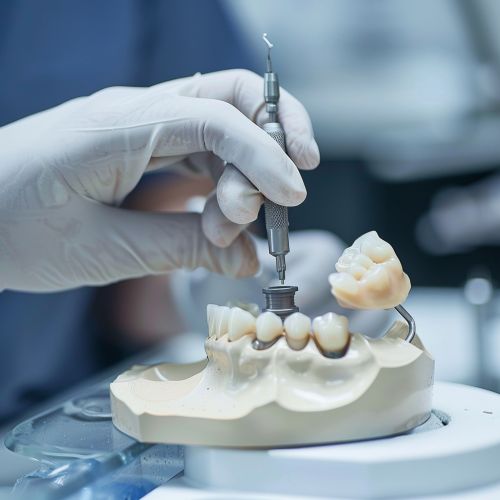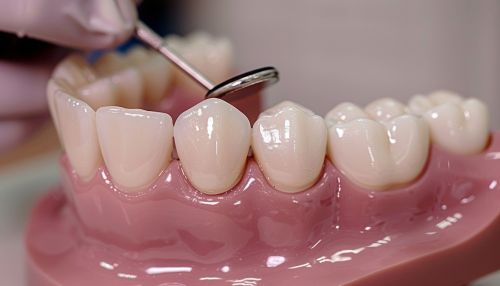Prosthodontics
Prosthodontics
Prosthodontics is a specialized branch of dentistry that focuses on the design, creation, and fitting of artificial replacements for teeth and other parts of the mouth. This field encompasses a wide range of treatments and procedures aimed at restoring oral function, comfort, appearance, and health. Prosthodontists are dental professionals who have completed additional training and education beyond general dentistry to become experts in this area.


History of Prosthodontics
The history of prosthodontics dates back to ancient civilizations, where rudimentary dental prostheses were crafted from materials such as ivory, bone, and wood. The Etruscans, for example, were known for their advanced dental techniques, including the use of gold bands to secure artificial teeth. The field has evolved significantly over the centuries, with major advancements occurring during the Renaissance period and the 19th century, when the development of porcelain teeth and vulcanite bases revolutionized dental prosthetics.
Types of Prosthodontic Treatments
Prosthodontic treatments can be broadly categorized into several types, each addressing specific dental issues:
Fixed Prosthodontics
Fixed prosthodontics involves the permanent attachment of dental prostheses, such as crowns, bridges, and veneers, to existing teeth or dental implants. These restorations are designed to provide long-term solutions for damaged or missing teeth.
Removable Prosthodontics
Removable prosthodontics includes partial and complete dentures that can be taken out by the patient. These prostheses are typically used when multiple teeth are missing and provide a cost-effective and non-invasive option for tooth replacement.
Implant Prosthodontics
Implant prosthodontics involves the use of dental implants to support prosthetic teeth. Dental implants are titanium posts surgically placed into the jawbone, providing a stable foundation for crowns, bridges, or dentures. This approach offers superior stability and functionality compared to traditional dentures.
Maxillofacial Prosthodontics
Maxillofacial prosthodontics is a subspecialty that focuses on the rehabilitation of patients with defects or disabilities involving the head and neck region. This includes the creation of prostheses for patients who have undergone surgery for oral cancer, trauma, or congenital conditions.
Materials Used in Prosthodontics
The materials used in prosthodontics have evolved significantly, with modern prostheses being crafted from a variety of advanced materials:
Metals
Metals such as gold, cobalt-chromium, and titanium are commonly used in prosthodontics for their strength, durability, and biocompatibility. These materials are often used in the fabrication of crowns, bridges, and dental implants.
Ceramics
Ceramics, including porcelain and zirconia, are widely used for their aesthetic properties and ability to mimic the natural appearance of teeth. Ceramic materials are often used in crowns, veneers, and implant-supported prostheses.
Polymers
Polymers, such as acrylic resins, are used in the fabrication of dentures and other removable prostheses. These materials are lightweight, easy to manipulate, and can be colored to match the patient's natural teeth and gums.
Techniques and Procedures
Prosthodontic treatments involve a series of techniques and procedures to ensure the successful restoration of oral function and aesthetics:
Diagnostic Phase
The diagnostic phase involves a comprehensive examination of the patient's oral health, including radiographs, impressions, and digital scans. This information is used to develop a customized treatment plan tailored to the patient's specific needs.
Treatment Planning
Treatment planning is a critical step in prosthodontics, involving the collaboration of the prosthodontist, dental technicians, and other specialists. The plan outlines the sequence of procedures, materials to be used, and the expected outcomes.
Fabrication of Prostheses
The fabrication of dental prostheses involves precise measurements, impressions, and the use of advanced laboratory techniques. Dental technicians play a crucial role in creating prostheses that fit accurately and function effectively.
Placement and Adjustment
The placement and adjustment of prostheses require meticulous attention to detail to ensure proper fit, function, and aesthetics. This may involve multiple appointments to make necessary adjustments and ensure patient comfort.
Advances in Prosthodontics
The field of prosthodontics has seen significant advancements in recent years, driven by technological innovations and research:
Digital Dentistry
Digital dentistry has revolutionized prosthodontics, with the use of computer-aided design and computer-aided manufacturing (CAD/CAM) technology. This allows for the precise fabrication of dental prostheses and reduces the time required for treatment.
3D Printing
3D printing technology has enabled the rapid production of dental models, surgical guides, and even prosthetic components. This technology offers increased accuracy and efficiency in the creation of dental prostheses.
Biocompatible Materials
The development of new biocompatible materials has improved the success rates and longevity of dental prostheses. These materials are designed to integrate seamlessly with the patient's natural tissues, reducing the risk of complications.
Challenges and Considerations
Prosthodontics presents several challenges and considerations that must be addressed to ensure successful outcomes:
Patient-Specific Factors
Each patient presents unique challenges, including variations in oral anatomy, medical history, and personal preferences. Prosthodontists must take these factors into account when developing treatment plans.
Cost and Accessibility
The cost of prosthodontic treatments can be a barrier for some patients, particularly those without dental insurance. Efforts to improve accessibility and affordability are ongoing within the field.
Long-Term Maintenance
Long-term maintenance of dental prostheses is essential for their success. Patients must be educated on proper care and regular follow-up appointments to monitor the condition of their prostheses.
Future Directions
The future of prosthodontics is promising, with ongoing research and technological advancements paving the way for new treatments and improved patient outcomes:
Regenerative Dentistry
Regenerative dentistry aims to restore natural tooth structures through the use of stem cells and tissue engineering. This emerging field holds the potential to revolutionize prosthodontic treatments by enabling the regeneration of damaged or missing tissues.
Artificial Intelligence
Artificial intelligence (AI) is being integrated into prosthodontics to enhance diagnostic accuracy, treatment planning, and the design of dental prostheses. AI-driven tools can analyze large datasets and provide insights that improve patient care.
Personalized Medicine
Personalized medicine approaches in prosthodontics involve tailoring treatments to the individual patient's genetic makeup, lifestyle, and specific needs. This approach aims to optimize treatment outcomes and enhance patient satisfaction.
